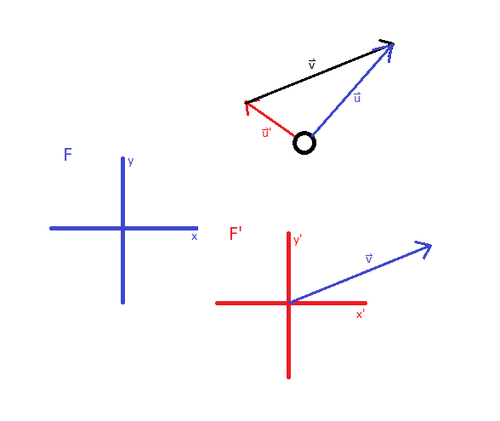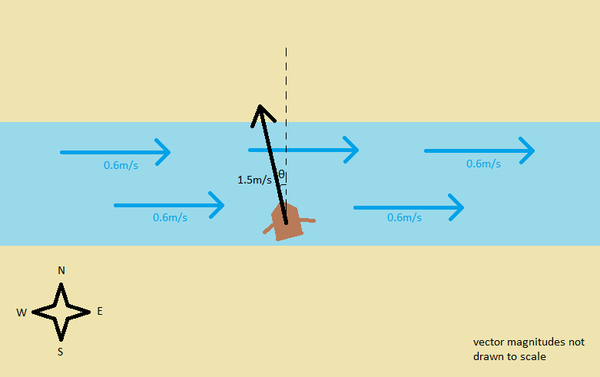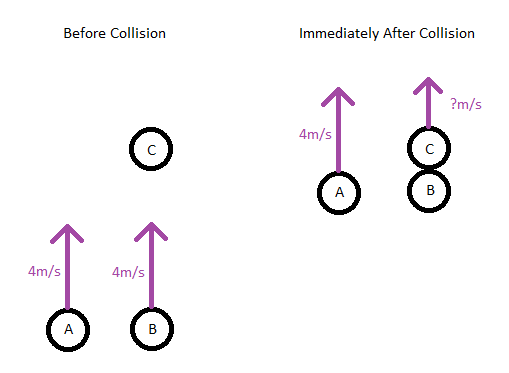Relative Velocity
This page defines and describes relative velocity.
The Main Idea
Velocity is a relative property, meaning that its value depends on the frame of reference from which it is observed and has no absolute "true" or "correct" value. This is because the position and therefore velocity of an object can only be defined relative to some coordinate system determined by the frame of reference chosen to model the situation. If two frames of reference are not moving with respect to each other, they will observe the same velocity for a given particle (even if their origins lie in different places), but if two frames of reference are moving with respect to each other, they will observe different velocity values for the same particle.
Consider a car driving down the highway. Suppose you want to determine the velocity of its driver. To do this, you must choose a frame of reference. You might choose the road, in which case the driver might have a velocity of 60mph in the northerly direction. However, you might also choose the car itself, in which case the driver would be at rest. The driver's position within the car does not change over time, so the velocity of the driver relative to the car is 0. You might even choose the center of the earth as a frame of reference, in which case the velocity of the driver would be more than 1000mph in the easterly direction due to the rotation of the earth (plus 60mph in the northerly direction because of the car's movement along the highway). The universe does not have a "natural" or "true" reference frame, so no choice of reference frame or observed velocity is more objectively correct than any other. That said, depending on why you want to know the driver's velocity, one choice of reference frame might be more useful to you than others for your specific situation. For example, if you are trying to determine how much danger the driver would be in in the event of a collision with a tree, you would want to know their velocity relative to that tree (which would be the same as their velocity relative to the road because the tree and the road are not moving with respect to each other). However, if you are trying to determine how much danger the driver would be in in the event of a collision with another car, you would want to know their velocity relative to that other car, which might be very low if the other car is traveling in the same direction or very high if the other car is traveling in the opposite direction.
A Mathematical Model
Observers in different reference frames may observe different velocities for the same particle, but that doesn't mean the two observations are unrelated to each other or cannot be compared. An equation exists that describes the relationship between velocities measured in different frames. That way, a velocity measured in one frame can be transformed to what it would be in another frame.
Consider two frames of reference: [math]\displaystyle{ F }[/math] and [math]\displaystyle{ F' }[/math]. Frame [math]\displaystyle{ F' }[/math] is moving with a constant velocity [math]\displaystyle{ \vec{v} }[/math] relative to [math]\displaystyle{ F }[/math] (meaning [math]\displaystyle{ F }[/math] is moving with a constant velocity [math]\displaystyle{ -\vec{v} }[/math] relative to [math]\displaystyle{ F' }[/math]). A particle has a velocity [math]\displaystyle{ \vec{u} }[/math] in frame [math]\displaystyle{ F }[/math] and a velocity [math]\displaystyle{ \vec{u}' }[/math] in frame [math]\displaystyle{ F' }[/math]. The following relationship exists between [math]\displaystyle{ \vec{u} }[/math] and [math]\displaystyle{ \vec{u}' }[/math]:
[math]\displaystyle{ \vec{u} = \vec{u}' + \vec{v} }[/math].
This equation is the result of the Galilean Transformation Equations, a set of equations that gives the relationship between position vectors in different frames of reference. It should make some amount of intuitive sense. Consider the example mentioned in the "main idea" section: A driver in a car driving north on a highway at 60mph. Let us say frame [math]\displaystyle{ F }[/math] is the road and [math]\displaystyle{ F' }[/math] is the car. [math]\displaystyle{ \vec{v} }[/math], the velocity of [math]\displaystyle{ F' }[/math] relative to [math]\displaystyle{ F }[/math], is therefore 60mph north. It makes geometric sense that the velocity of the driver relative to the road is 60mph north plus the velocity of the driver relative to the car (which for this particular example would be 0 if we assume safe driving habits).
Examples
1. (Simple)
An airplane is flying with a velocity of [math]\displaystyle{ \left \langle {150,20,0} \right \rangle }[/math] km/h relative to the air. It is a windy day, so the air is moving with a velocity of [math]\displaystyle{ \left \langle {-25,0,-10} \right \rangle }[/math] km/h relative to the ground. What is the velocity of the plane relative to the ground?
Solution:
There are two frames of reference in this problem: the air and the ground. We are given the velocity of the plane relative to the air and are asked to find it relative to the ground. Since we are given that the air is moving with velocity [math]\displaystyle{ \left \langle {-25,0,-10} \right \rangle }[/math] km/h relative to the ground, let us call the air [math]\displaystyle{ F' }[/math], making [math]\displaystyle{ \vec{v} }[/math] [math]\displaystyle{ \left \langle {-25,0,-10} \right \rangle }[/math] km/h and [math]\displaystyle{ \vec{u}' }[/math] [math]\displaystyle{ \left \langle {150,20,0} \right \rangle }[/math] km/h.
[math]\displaystyle{ \vec{u} = \vec{u}' + \vec{v} }[/math]
[math]\displaystyle{ \vec{u}_{Airplane/ground} = \left \langle {150,20,0} \right \rangle + \left \langle {-25,0,-10} \right \rangle }[/math]
[math]\displaystyle{ \vec{u}_{Airplane/ground} = \left \langle {125,20,-10} \right \rangle }[/math]
2. (Middling)
A rower can row their rowboat at a speed of 1.5m/s relative to the water. The rower comes to a straight river flowing to the east at a speed of 0.6m/s. The rower wants to cross the river perpendicularly from south to north. At what angle [math]\displaystyle{ \theta }[/math] west of north should the rower row so that the boat travels in a straight perpendicular line across the river from the point of view of the riverbank?
Solution:
Let us call east and north the +x and +y directions respectively.
In this problem, there are two frames of reference: the water and the riverbank. Using trigonometry, we can find the velocity of the rowboat relative to the water: [math]\displaystyle{ \left \langle {-1.5\sin\theta,1.5\cos\theta} \right \rangle }[/math]m/s.
By the formula [math]\displaystyle{ \vec{u} = \vec{u}' + \vec{v} }[/math], the velocity of the rowboat relative to the riverbank equals the velocity of the rowboat relative to the water plus the velocity of the water relative to the riverbank:
[math]\displaystyle{ \vec{u}_{rowboat/riverbank} = \left \langle {-1.5\sin\theta,1.5\cos\theta}m/s \right \rangle + \left \langle {0.6,0} \right \rangle }[/math]m/s
[math]\displaystyle{ \vec{u}_{rowboat/riverbank} = \left \langle {-1.5\sin\theta+0.6,1.5\cos\theta}m/s \right \rangle }[/math]m/s
The rower's goal is for the boat to cross the river perpendicularly from the point of view of the riverbank. That is, [math]\displaystyle{ \vec{u}_{rowboat/riverbank} }[/math] must have only a y component; the x component must be equal to 0, or the boat's path would not be perpendicular to the river.
[math]\displaystyle{ -1.5\sin\theta+0.6 = 0 }[/math]
[math]\displaystyle{ -1.5\sin\theta = -0.6 }[/math]
[math]\displaystyle{ \sin\theta = \frac{0.6}{1.5} }[/math]
[math]\displaystyle{ \theta = \sin^{-1}(\frac{0.6}{1.5}) = 23.6 }[/math]
3. (Difficult)
Note: this problem requires knowledge of collisions.
Alice, Bob, and Charlie, go ice skating together. Alice and Bob are skating next to each other in the same direction at 4m/s (relative to the ice skating rink) when Bob accidentally collides with Charlie, who is initially at rest (relative to the ice skating rink). Bob and Charlie grab onto each other as they collide to stabilize themselves, so their collision is inelastic and Bob and Charlie end up at the same speed. Bob weighs 60kg and Charlie weighs 80kg. What is the final speed of Bob and Charlie? Assume that there is no friction between the skates and the ice. Solve this problem using conservation of momentum in two different reference frames: the ice skating rink and Alice. Show that both solutions agree with each other.
Solution:
This is a one-dimensional problem because the trajectories of both Bob and Charlie are constrained to the same axis. Let us define the positive direction as the direction in which Bob is initially traveling.
First let us solve the problem from the reference frame of the ice skating rink. Relative to the ice skating rink, the initial velocities of Bob and Charlie are 4m/s and 0m/s respectively. This means their momenta are 240kgm/s and 0kgm/s respectively. The initial total momentum of the Bob-Charlie system is therefore 240kgm/s. Since this collision occurs in isolation of any external forces, the final momentum of the system is also 240kgm/s. Bob and Charlie are moving together at the end of the collision. Their combined mass is 140kg, so their velocity must be [math]\displaystyle{ \frac{240}{140} = 1.71 }[/math]m/s.
Now let us solve the problem from the reference frame of Alice. Relative to the ice skating rink, the initial velocities of Bob and Charlie are 0m/s and -4m/s respectively. (If you cannot tell this intuitively, you can calculate it by using the relative velocity transformation equation [math]\displaystyle{ \vec{u} = \vec{u}' + \vec{v} }[/math].) This means their momenta are 0kgm/s and -320kgm/s respectively. The initial total momentum of the Bob-Charlie system is therefore -320kgm/s. Since this collision occurs in isolation of any external forces, the final momentum of the system is also -320kgm/s. Bob and Charlie are moving together at the end of the collision. Their combined mass is 140kg, so their velocity must be [math]\displaystyle{ \frac{-320}{140} = -2.29 }[/math]m/s.
Now let us show that our two answers are consistent with each other despite being numerically different. Relative to Alice, we found that the final velocity of Bob and Charlie is -2.29m/s. However, Alice is herself moving relative to the ice skating rink at a velocity of 4m/s. Using the equation [math]\displaystyle{ \vec{u} = \vec{u}' + \vec{v} }[/math], the final velocity of Bob and Charlie relative to the ice skating rink is -2.29 + 4 = 1.71m/s. This numerically matches the calculations we did from the reference frame of the ice skating rink.
This problem shows that the relative nature of velocity translates to other properties that depend on velocity, such as kinetic energy and momentum. Calculations involving these properties can be correctly performed from a variety of reference frames.
Connectedness
Since the goal of the field of mechanics is to predict the motion of systems, velocity is critical to this branch of physics. In addition to being a value of interest in and of itself, properties such as Linear Momentum, Angular Momentum, and Magnetic Force depend on the velocities of objects.
Because velocity is relative, properties that depend on it are also relative. That is, properties such as momentum and energy might have different values when measured relative to different reference frames. This fits into the larger theme in physics that a problem can be solved from different, equally valid perspectives.
History
The equation to convert between relative velocities was the natural result of the Galilean transformation equations. Although they are named after Galileo Galilei, those equations are in turn the natural result of Newton's perception of space and time as he described them in Principia Mathematica3. Although no one in particular is credited with the Galilean transformation equations, both Newton and Galileo (and many other physicists) used them. They remained unchanged until the early 20th century, at which time Albert Einstein rewrote them to accommodate his theories of relativity. Einstein also famously said that it is impossible to tell the velocity of one's reference frame by performing experiments locally, popularizing the idea that no frame was more legitimate or correct than any other frame.
See also
External links
References
- Chabay, Ruth W., and Bruce A. Sherwood. Matter and Interactions. Hoboken, NJ: Wiley, 2011. Print.
- Wikipedia contributors. (2019, June 7). Relative velocity. In Wikipedia, The Free Encyclopedia. Retrieved 16:06, August 11, 2019, from https://en.wikipedia.org/w/index.php?title=Relative_velocity&oldid=900770643
- Wikipedia contributors. (2019, July 18). Galilean transformation. In Wikipedia, The Free Encyclopedia. Retrieved 16:57, August 11, 2019, from https://en.wikipedia.org/w/index.php?title=Galilean_transformation&oldid=906797474
- HyperPhysics: Relative Motion
- Example from Frame of Reference


